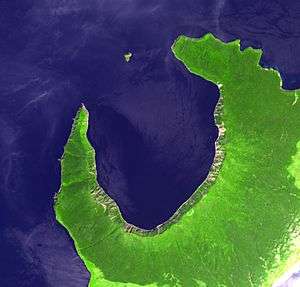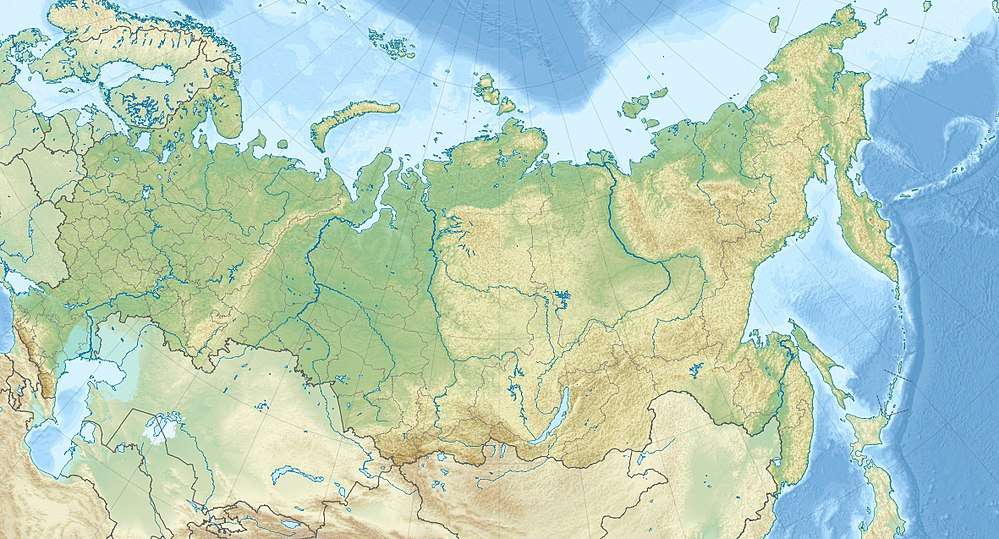Lvinaya Past
Moekeshiwan, also known as Lvinaya Past (Russian: Львиная Пасть, literally "Lion's Maw", after a rock that emerges from the sea and resembles a sleeping lion), is a volcano in the southern part of Iturup in the Kuril Islands, claimed by Japan and administered by Russia.[1] The volcano is characterized by a large caldera that is flooded by the Sea of Okhotsk. A large eruption occurred early during the Holocene which reached a volcanic explosivity index of 7.
| Lvinaya Past | |
|---|---|
 | |
| Highest point | |
| Elevation | 528 m (1,732 ft) |
| Coordinates | 44.608°N 146.994°E |
| Geography | |
 Lvinaya Past Location of Lvinaya Past in Russia | |
| Location | Iturup, Kuril Islands, Russia |
| Geology | |
| Mountain type | Stratovolcano / Caldera |
| Last eruption | 7480 BC ± 80 years |
Iturup island contains about nine stratovolcanoes, some pyroclastic cones, one somma volcano and several geothermal fields.[2]:166 Among these, Lvinaya Past is formed by a 7-by-9-kilometre (4.3 mi × 5.6 mi) wide[3] and 550-metre (1,800 ft) deep caldera, which is connected with the Sea of Okhotsk by a 5-kilometre (3.1 mi) wide and maximally 50-metre (160 ft) deep strait.[1] The volcano is 528 metres (1,732 ft) high,[3] almost 1 kilometre (0.62 mi) above the bottom of the caldera.[1]
A major eruption occurred 7480 ± 80 BC.[4]:419 The submarine caldera formed during this eruption and heavily altered the topography on Iturup, generating an ignimbrite[5]:188 which joined the three southernmost volcanoes of Iturup to the main island.[1] The total volume of tephra ejected amounts to 170 cubic kilometres (41 cu mi).[6]:131 This eruption had a volcanic explosivity index of 7,[4]:419 making it one of the largest eruptions that are known to have occurred in the Kuril Islands,[1][5]:189 and the strongest known to have occurred during the Holocene in the Southern Kurils.[7]:64 Habitats may have been destroyed to distances of 50 kilometres (31 mi) from the volcano.[8]:137 The development of alder-containing birch forests in the region may have been favoured by the ash fall from the eruption, which would have killed more susceptible conifers.[6]:131
Ice cores taken in the Siberian Altai demonstrate increased sulfate concentrations at the time, possibly stemming from large sulfate release by the eruptions of Lvinaya Past and contemporaneous large scale activity at Caldera Fisher in Alaska and Pinatubo in the Philippines.[4]:419
Lvinaya Past has erupted tholeiitic magmas with a low potassium content.[9]:392 Other rocks include andesite, basaltic andesite, basalt, dacite and picrite.[1] The caldera-forming eruption ejected dacitic material with hornblende and quartz forming phenocrysts.[7]:73 Other volcanoes on Iturup include Astonupuri, Baransky, Berutarube, Bogatyr Ridge, Chirip, Demon, Golets-Tornyi, Grozny Group, Medvezhy and Past.[2]:166
See also
References
- Moekeshiwan (Lvinaya Past). Smithsonian Institution: Global Volcanism Program. Accessed November 2015.
- Glasby, G. P.; Cherkashov, G. A.; Gavrilenko, G. M.; Rashidov, V. A.; Slovtsov, I. B. (2006-09-20). "Submarine hydrothermal activity and mineralization on the Kurile and western Aleutian island arcs, N.W. Pacific". Marine Geology. 231 (1–4): 163–180. doi:10.1016/j.margeo.2006.06.003.
- Oppenheimer, Clive (2011-05-26). Eruptions that Shook the World. Cambridge University Press. p. 359. ISBN 9781139496391.
- Aizen, Elena M.; Aizen, Vladimir B.; Takeuchi, Nozomu; Mayewski, Paul A.; Grigholm, Bjorn; Joswiak, Daniel R.; Nikitin, Stanislav A.; Fujita, Koji; Nakawo, Masayoshi (2016-06-01). "Abrupt and moderate climate changes in the mid-latitudes of Asia during the Holocene". Journal of Glaciology. 62 (233): 411–439. doi:10.1017/jog.2016.34. ISSN 0022-1430.
- MacInnes, Breanyn; Fitzhugh, Ben; Holman, Darryl (2014-06-01). "Controlling for Landform Age When Determining the Settlement History of the Kuril Islands". Geoarchaeology. 29 (3): 185–201. doi:10.1002/gea.21473. ISSN 1520-6548. PMC 4326108. PMID 25684855.
- Razjigaeva, Nadezhda G.; Ganzey, Larisa A.; Grebennikova, Tatyana A.; Belyanina, Nina I.; Mokhova, Ludmila M.; Arslanov, Khikmat A.; Chernov, Sergei B. (2013-03-21). "Holocene climatic changes and vegetation development in the Kuril Islands". Quaternary International. The Baikal-Hokkaido Archaeology Project: Environmental archives, proxies and reconstruction approaches. 290–291: 131. doi:10.1016/j.quaint.2012.06.034.
- Razzhigaeva, Nadezhda G.; Matsumoto, Akiko; Nakagawa, Mitsuhiro (2016-03-18). "Age, source, and distribution of Holocene tephra in the southern Kurile Islands: Evaluation of Holocene eruptive activities in the southern Kurile arc". Quaternary International. Japanese Quaternary Studies. 397: 63–78. doi:10.1016/j.quaint.2015.07.070.
- Hopi, Hoekstra; William, Fagan (1998-05-01). "Body size, dispersal ability and compositional disharmony: the carnivore‐dominated fauna of the Kuril Islands". Diversity and Distributions. 4 (3): 135–149. doi:10.1046/j.1365-2699.1998.00016.x. ISSN 1472-4642.
- Volynets, Oleg N. (1994-04-01). "Geochemical Types, Petrology, and Genesis of Late Cenozoic Volcanic Rocks from the Kurile-Kamchatka Island-Arc System". International Geology Review. 36 (4): 373–405. doi:10.1080/00206819409465467. ISSN 0020-6814.